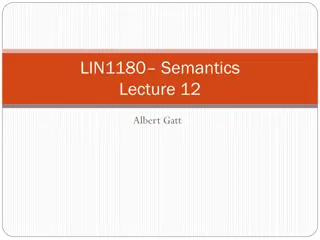Understanding the Past Continuous Tense in English Grammar
Past Continuous Tense is used to describe ongoing actions in the past. It is formed with "was/were" + present participle (-ing). Learn its structure, usage, negation, and questioning forms with examples. Enhance your English grammar skills by mastering the Past Continuous Tense.
Download Presentation

Please find below an Image/Link to download the presentation.
The content on the website is provided AS IS for your information and personal use only. It may not be sold, licensed, or shared on other websites without obtaining consent from the author. Download presentation by click this link. If you encounter any issues during the download, it is possible that the publisher has removed the file from their server.
E N D
Presentation Transcript
Department of biology ENGLISH 1 stage By RAQIB ABBAS
Past Continuous Tense ---The past continuous tense is used to describe an action or state that was ongoing at a specific time in the past. - It is formed by using the past tense of the verb "to be" (was/were) followed by the present participle of the main verb (-ing). ---S+ Was , were + v ( ing ) + C .. ---Examples: 1. I was walking to school when I saw a bird. 2. The children were playing in the park all afternoon. 3. It was raining heavily when we left the house. 4. She was cooking dinner when her husband came home. 5. We were watching a movie when the power went out. 6. The students were studying for their exams all week. 7. The car was speeding down the highway when it crashed. 8. The teacher was explaining the lesson when the bell rang. 9. I was listening to music while I was doing my homework. 10. The birds were singing in the trees as the sun rose.
Negative --The negative past continuous tense is used to indicate that an action was not happening at a specific moment in the past. -- It is formed using the past tense of the verb "to be" (was/were) + "not" + the present participle (verb+ing). ---Subject + was/were + not + verb-ing + c -Examples: I was not watching TV when you called. She was not reading a book when the power went out. They were not playing soccer in the park at 5 PM. He was not studying for the exam last night. We were not driving to the beach when it started raining. You were not listening to music when I arrived. The children were not sleeping when the thunderstorm began. She was not working on her project during the weekend. I was not cooking dinner when you knocked on the door. He was not talking on the phone when I entered the room.
Question --The question form of the past continuous tense is used to ask if an action was happening at a specific moment in the past. -- It is formed using the past tense of the verb "to be" (was/were) followed by the subject and the present participle (verb+ing). ---Was/Were + subject + verb-ing? --Examples: Were you watching TV when I called? Was she reading a book when the power went out? Were they playing soccer in the park at 5 PM? Was he studying for the exam last night? Were we driving to the beach when it started raining? Were you listening to music when I arrived? Were the children sleeping when the thunderstorm began? Was she working on her project during the weekend? Was I cooking dinner when you knocked on the door? Was he talking on the phone when I entered the room?























